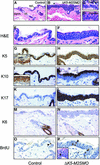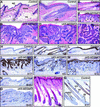The magnitude of hedgehog signaling activity defines skin tumor phenotype
- PMID: 12773389
- PMCID: PMC156767
- DOI: 10.1093/emboj/cdg271
The magnitude of hedgehog signaling activity defines skin tumor phenotype
Abstract
Gain-of-function mutations in SMO have been implicated in constitutive activation of the hedgehog signaling pathway in human basal cell carcinomas (BCCs). We used a truncated keratin 5 (DeltaK5) promoter to assess the potential role of the human M2SMO mutant in BCC development in adult transgenic mice. DeltaK5-M2SMO mouse epidermis is hyperproliferative, ex presses BCC protein markers and gives rise to numerous epithelial downgrowths invading the underlying dermis. Lesions strikingly similar to human basaloid follicular hamartomas develop, but BCCs do not arise even in elderly mice. Hedgehog target gene transcripts were only modestly upregulated in mouse and human follicular hamartomas, in contrast to the high levels detected in BCCs. Cyclins D1 and D2 were selectively upregulated in mouse BCCs. Our data suggest that the levels of hedgehog pathway activation and G(1) cyclins are major determinants of tumor phenotype in skin, and strongly implicate deregulated hedgehog signaling in the genesis of human basaloid follicular hamartomas. Expression of an activated SMO mutant in keratinocytes appears to be insufficient for the development and/or maintenance of full-blown BCCs.
Figures






Similar articles
-
Dissecting the oncogenic potential of Gli2: deletion of an NH(2)-terminal fragment alters skin tumor phenotype.Cancer Res. 2002 Sep 15;62(18):5308-16. Cancer Res. 2002. PMID: 12235001
-
Protein kinase A activation inhibits oncogenic Sonic hedgehog signalling and suppresses basal cell carcinoma of the skin.Exp Dermatol. 2012 Nov;21(11):847-52. doi: 10.1111/exd.12016. Exp Dermatol. 2012. PMID: 23163650
-
Activating Smoothened mutations in sporadic basal-cell carcinoma.Nature. 1998 Jan 1;391(6662):90-2. doi: 10.1038/34201. Nature. 1998. PMID: 9422511
-
Basal cell carcinoma and the carcinogenic role of aberrant Hedgehog signaling.Future Oncol. 2010 Jun;6(6):1003-14. doi: 10.2217/fon.10.49. Future Oncol. 2010. PMID: 20528237 Review.
-
Interaction of hedgehog and vitamin D signaling pathways in basal cell carcinomas.Adv Exp Med Biol. 2014;810:329-41. doi: 10.1007/978-1-4939-0437-2_18. Adv Exp Med Biol. 2014. PMID: 25207374 Review.
Cited by
-
Sustained Hedgehog signaling is required for basal cell carcinoma proliferation and survival: conditional skin tumorigenesis recapitulates the hair growth cycle.Genes Dev. 2005 Jan 15;19(2):214-23. doi: 10.1101/gad.1258705. Epub 2004 Dec 29. Genes Dev. 2005. PMID: 15625189 Free PMC article.
-
Epidermal stem cells of the skin.Annu Rev Cell Dev Biol. 2006;22:339-73. doi: 10.1146/annurev.cellbio.22.010305.104357. Annu Rev Cell Dev Biol. 2006. PMID: 16824012 Free PMC article. Review.
-
Lack of evidence for activation of the hedgehog pathway in psoriasis.J Invest Dermatol. 2009 Mar;129(3):635-40. doi: 10.1038/jid.2008.266. Epub 2008 Aug 28. J Invest Dermatol. 2009. PMID: 18754037 Free PMC article.
-
Hairy tale of signaling in hair follicle development and cycling.Semin Cell Dev Biol. 2012 Oct;23(8):906-16. doi: 10.1016/j.semcdb.2012.08.003. Epub 2012 Aug 22. Semin Cell Dev Biol. 2012. PMID: 22939761 Free PMC article. Review.
-
Overexpression of Desmoglein 2 in a Mouse Model of Gorlin Syndrome Enhances Spontaneous Basal Cell Carcinoma Formation through STAT3-Mediated Gli1 Expression.J Invest Dermatol. 2019 Feb;139(2):300-307. doi: 10.1016/j.jid.2018.09.009. Epub 2018 Oct 3. J Invest Dermatol. 2019. PMID: 30291846 Free PMC article.
References
-
- Akiyama H., Shigeno,C., Hiraki,Y., Shukunami,C., Kohno,H., Akagi,M., Konishi,J. and Nakamura,T. (1997) Cloning of a mouse smoothened cDNA and expression patterns of hedgehog signalling molecules during chondrogenesis and cartilage differentiation in clonal mouse EC cells, ATDC5. Biochem. Biophys. Res. Commun., 235, 142–147. - PubMed
-
- Aszterbaum M., Epstein,J., Oro,A., Douglas,V., LeBoit,P.E., Scott,M.P. and Epstein,E.H.,Jr (1999) Ultraviolet and ionizing radiation enhance the growth of BCCs and trichoblastomas in patched heterozygous knockout mice. Nat. Med., 5, 1285–1291. - PubMed
-
- Bailleul B., Surani,M.A., White,S., Barton,S.C., Brown,K., Blessing,M., Jorcano,J. and Balmain,A. (1990) Skin hyperkeratosis and papilloma formation in transgenic mice expressing a ras oncogene from a suprabasal keratin promoter. Cell, 62, 697–708. - PubMed
-
- Brown K., Strathdee,D., Bryson,S., Lambie,W. and Balmain,A. (1998) The malignant capacity of skin tumours induced by expression of a mutant H-ras transgene depends on the cell type targeted. Curr. Biol., 8, 516–524. - PubMed
-
- Brownstein M.H. (1992) Basaloid follicular hamartoma: solitary and multiple types. J. Am. Acad. Dermatol., 27, 237–240. - PubMed
Publication types
MeSH terms
Substances
Grants and funding
LinkOut - more resources
Full Text Sources
Other Literature Sources
Medical
Molecular Biology Databases
Research Materials
Miscellaneous

